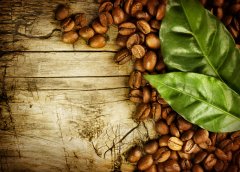Ecuadorian coffee producing area San Cristobal Galapagos Coffee
Due to the unique role of the Galapagos Islands in the course of history, the Government of Ecuador has designated the Galapagos Islands as a national park and no longer allows land to be reclaimed as new agricultural land. and the introduction and use of chemical fertilizers, pesticides, herbicides and other chemicals are strictly prohibited, so coffee produced in the Galapagos Islands is recognized as a natural product.
It's increasing. The best Arabica coffee comes from the Andes, especially the ChanchamgoValley Valley, which divides into two mountains, stretching from south to north to central Ecuador. As coffee is consumed by people all over the world, the world coffee industry is also moving towards mass production, while a smaller coffee industry like St. Cristobal is in trouble and may well be forced to give up without profit. It wasn't until the early 1990s that the Gonzalez family bought Hasunda Coffee Park. The localized microclimate caused by the Humboldt current (HumboldtCurrent), strong equatorial sunlight and sharp temperature changes (43 ℃ at sea level and 10 ℃ to 16 ℃ above sea level) provided advantageous conditions that prompted the Gonzalez family to expand their coffee plantation. Through the reclamation of early land, the Gonzalez family doubled the size of the coffee plantation. 340 years after Frey Thomas de Belanga discovered the island, in 1875, a native named Kovos came to St. Cristobal Island, where he established the Hasunda Coffee Garden and planted about 100 hectares of Arabian bourbon coffee trees. Because the plantation is located between 140m and 275m above sea level and its climate is equivalent to that of inland 915m ~ 1830 m, the unique geographical conditions are very suitable for the growth of high acidity extra hard coffee beans (SHB). So this kind of high-quality coffee is settled here. St. Cristobal is a larger island in the Galapagos Islands, and there is a small lake called El.Junco 410m above sea level. The lake forms several streams that flow along the rocks and volcanic rocks on the southern slope of the island, and mineral-rich fresh water moistens the land of St. Cristobal, keeping the soil moist and fertile. Provide the most rare conditions for the growth of coffee here.

Important Notice :
前街咖啡 FrontStreet Coffee has moved to new addredd:
FrontStreet Coffee Address: 315,Donghua East Road,GuangZhou
Tel:020 38364473
- Prev

Sunburn Yega Chefe Ethiopia Eriga aricha Manor Kebel Aricha processing Plant
The harvesting method and refining method are adopted. Generally speaking, it is better to adopt manual harvesting method and water washing refining method. A variety of fine coffee. It is better to use Arabica inherent variety Tibica or bourbon variety. Is the altitude, topography, climate, soil and refinement of the cultivated land or farm clear? Generally speaking, the coffee with high altitude is of higher quality, and the fertile volcanic soil is the best soil.
- Next

How to make Mexican coffee?
The selection of Mexican coffee is generally done manually. The main basis for selection is according to the fullness of coffee particles, whether uniform, and then divided into grades. Generally speaking, coffee with full and uniform particles is easier to preserve. Only the purest and most uniform coffee beans can be roasted to represent the best and finest coffee in the country. After the worker picks the coffee beans, he puts the coffee
Related
- Does Rose Summer choose Blue, Green or Red? Detailed explanation of Rose Summer Coffee plots and Classification in Panamanian Jade Manor
- What is the difference between the origin, producing area, processing plant, cooperative and manor of coffee beans?
- How fine does the espresso powder fit? how to grind the espresso?
- Sca coffee roasting degree color card coffee roasting degree 8 roasting color values what do you mean?
- The practice of lattes: how to make lattes at home
- Introduction to Indonesian Fine Coffee beans-- Java Coffee producing area of Indonesian Arabica Coffee
- How much will the flavor of light and medium roasted rose summer be expressed? What baking level is rose summer suitable for?
- Introduction to the characteristics of washing, sun-drying or wet-planing coffee commonly used in Mantenin, Indonesia
- Price characteristics of Arabica Coffee Bean Starbucks introduction to Manning Coffee Bean Taste producing area Variety Manor
- What is the authentic Yega flavor? What are the flavor characteristics of the really excellent Yejasuffi coffee beans?

